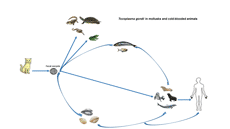Crossref Citations
This article has been cited by the following publications. This list is generated based on data provided by
Crossref.
Loss, Scott R.
Boughton, Brooke
Cady, Samantha M.
Londe, David W.
McKinney, Caleb
O'Connell, Timothy J.
Riggs, Georgia J.
and
Robertson, Ellen P.
2022.
Review and synthesis of the global literature on domestic cat impacts on wildlife.
Journal of Animal Ecology,
Vol. 91,
Issue. 7,
p.
1361.
López Ureña, Nadia María
Chaudhry, Umer
Calero Bernal, Rafael
Cano Alsua, Santiago
Messina, Davide
Evangelista, Francisco
Betson, Martha
Lalle, Marco
Jokelainen, Pikka
Ortega Mora, Luis Miguel
and
Álvarez García, Gema
2022.
Contamination of Soil, Water, Fresh Produce, and Bivalve Mollusks with Toxoplasma gondii Oocysts: A Systematic Review.
Microorganisms,
Vol. 10,
Issue. 3,
p.
517.
Mani, Rajesh
Abdelaziz, Mohamed H.
Michelon, Alexandra
and
Suzuki, Yasuhiro
2022.
Human MHC class I molecule, HLA-A2.1, mediates activation of CD8+ T cell IFN-γ production and the T cell-dependent protection against reactivation of cerebral Toxoplasma infection.
Frontiers in Immunology,
Vol. 13,
Issue. ,
Merks, Harriet
Boone, Ryan
Janecko, Nicol
Viswanathan, Mythri
and
Dixon, Brent R.
2023.
Foodborne protozoan parasites in fresh mussels and oysters purchased at retail in Canada.
International Journal of Food Microbiology,
Vol. 399,
Issue. ,
p.
110248.
Li, Yuantao
Guo, Jingjing
Zhang, Haixia
Li, Zhidan
Ren, Yushan
Jiang, Yuzhu
Liu, Xianbing
and
Hu, Xuemei
2023.
LILRB4 regulates the function of decidual MDSCs via the SHP-2/STAT6 pathway during Toxoplasma gondii infection.
Parasites & Vectors,
Vol. 16,
Issue. 1,
Nayeri, Tooran
Sarvi, Shahabeddin
and
Daryani, Ahmad
2023.
Possible Association between Toxoplasma gondii Infection and Sleep
Disorders: A Systematic Review.
Infectious Disorders - Drug Targets,
Vol. 23,
Issue. 8,
Mendoza Roldan, Jairo Alfonso
and
Otranto, Domenico
2023.
Zoonotic parasites associated with predation by dogs and cats.
Parasites & Vectors,
Vol. 16,
Issue. 1,
Kulawik, Piotr
Rathod, Nikheel Bhojraj
Ozogul, Yesim
Ozogul, Fatih
and
Zhang, Wangang
2023.
Recent developments in the use of cold plasma, high hydrostatic pressure, and pulsed electric fields on microorganisms and viruses in seafood.
Critical Reviews in Food Science and Nutrition,
Vol. 63,
Issue. 29,
p.
9716.
Mancusi, Andrea
Proroga, Yolande T. R.
Giordano, Angela
Girardi, Santa
D’Orilia, Francescantonio
Pinto, Renato
Sarnelli, Paolo
Rinaldi, Laura
Capuano, Federico
and
Maurelli, Maria Paola
2023.
First application of a droplet digital PCR to detect Toxoplasma gondii in mussels.
Frontiers in Microbiology,
Vol. 14,
Issue. ,
Ghozzi, Khemissa
Nakbi, Amel
Challouf, Rafika
and
Dhiab, Rym Ben
2023.
A review on microbial contamination cases in Tunisian coastal marine areas.
Water Science & Technology,
Vol. 87,
Issue. 9,
p.
2142.
Nayeri, Tooran
Moosazadeh, Mahmood
Asl, Abdolhossein Dalimi
Ghaffarifar, Fatemeh
Sarvi, Shahabeddin
Daryani, Ahmad
and
Hosseini Farash, Bibi Razieh
2023.
Toxoplasma infection and Rhesus blood group system: A systematic review and meta-analysis.
PLOS ONE,
Vol. 18,
Issue. 7,
p.
e0287992.
Symeonidou, Isaia
Sioutas, Georgios
Lazou, Thomai
Gelasakis, Athanasios I.
and
Papadopoulos, Elias
2023.
A Review of Toxoplasma gondii in Animals in Greece: A FoodBorne Pathogen of Public Health Importance.
Animals,
Vol. 13,
Issue. 15,
p.
2530.
Uribe Corrales, Natalia
2023.
Epidemic Preparedness and Control.
Singh, Jasdeep Kaur Darsan
Mazumdar, Purabi
Othman, Rofina Yasmin
and
Harikrishna, Jennifer Ann
2024.
Adding value to banana farming: Antibody production in post-harvest leaves.
Journal of Biotechnology,
Vol. 387,
Issue. ,
p.
69.
Nayeri, Tooran
Sarvi, Shahabeddin
and
Daryani, Ahmad
2024.
Effective factors in the pathogenesis of Toxoplasma gondii.
Heliyon,
Vol. 10,
Issue. 10,
p.
e31558.
Pagheh, Abdol Sattar
Talebian, Adele Sadat
Nayeri, Tooran
Esmaeili, Ali Akbar
Rezaei, Fatemeh
Nazar, Eisa
and
Ziaee, Masood
2025.
Association between latent toxoplasmosis and bipolar disorder: a case-control seroprevalence study.
BMC Infectious Diseases,
Vol. 25,
Issue. 1,
Athayde-Gusmão, Anna Elisa
Afonso, Bianca Cardozo
Frazão-Teixeira, Edwards
Calais, Antônio
Ferreira, Regiane de Fátima
Egert, Leandro
Mayorga, Luis Felipe
Rosa, Maria Ferreira
Silveira, Leonardo Serafim da
Ubiali, Daniel Guimarães
and
da Silva, Andressa Ferreira
2025.
First report of anti-Toxoplasma gondii antibodies in sea turtles.
Veterinary Parasitology: Regional Studies and Reports,
Vol. 61,
Issue. ,
p.
101263.
Salim, Mubashra
Khan, Asmat Ullah
Niazi, Alaudin Khan
Aqdas, Amna
Dawoud, Turki M.
Usman, Muhammad
Muqaddas, Hira
Ullah, Shakir
Belkahia, Hanène
Khan, Adil
Ben Said, Mourad
and
Iqbal, Furhan
2025.
Molecular detection and phylogenetic identification of Toxoplasma gondii-like strains, Hepatozoon ixoxo and Lankesterella sp. in frogs and toads.
Frontiers in Veterinary Science,
Vol. 12,
Issue. ,
Han, Chengquan
Qi, Xin
Liu, Xinyu
Hu, Minjie
Zhao, Qihui
Guan, Lizeng
and
Xu, Lu
2025.
Integrated network pharmacology, molecular docking and in vivo experiments to elucidate the extenuative mechanisms of ginseng polysaccharide against Toxoplasma gondii-induced testicular toxicity.
International Immunopharmacology,
Vol. 148,
Issue. ,
p.
114147.
Qiu, Yanhua
Wang, Weiwei
Wang, Qing
Xu, Jing
Dai, Guonian
Bai, Yubin
and
Zhang, Jiyu
2025.
Activity Evaluation and Mode of Action of ICA Against Toxoplasma gondii In Vitro.
Biomolecules,
Vol. 15,
Issue. 2,
p.
202.
